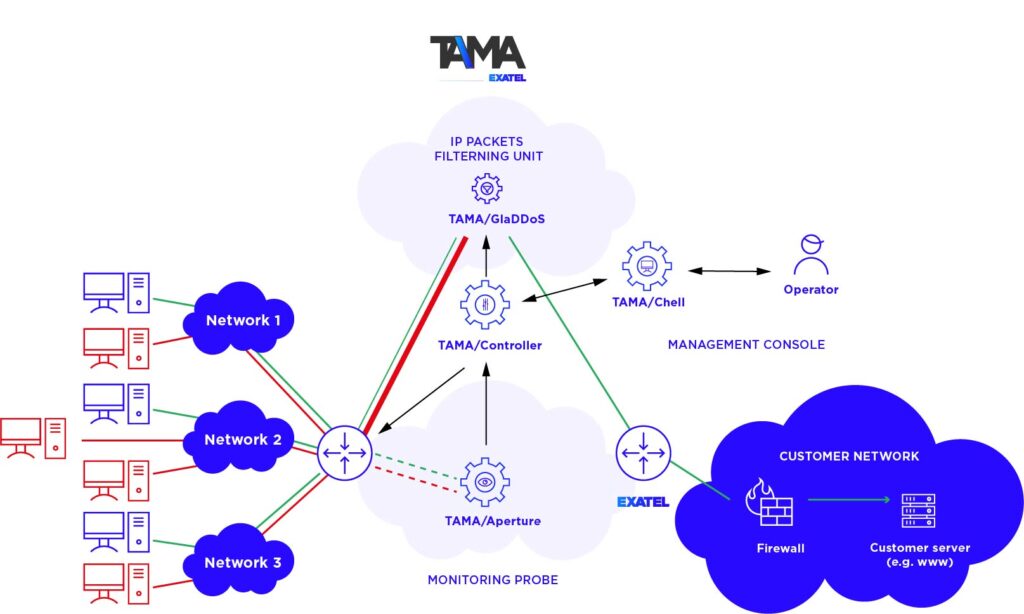A project by EXATEL and the Warsaw University of Technology has been accepted by the National Centre for Research and Development. This is a great opportunity to develop the first operator-class DDoS-protection system in Poland. The results of the 2nd Competition within the CyberSecIdent program – Cybersecurity and e-Identity – were announced on 8 December 2017. The project called ‘TAMA anti-DDoS’ found its place in an elite group of ventures recommended for financing by the NCBiR (National Centre for Research and Development).
Why do we need anti-DDoS tools?
Digitization of the economy and public life means their much more efficient functioning, huge savings and increased quality of life for everyone. Unfortunately, there is also the other side of the coin. Democratization of access to digital tools provides increased opportunities for criminal activity. Until just a few years ago, attacks on infrastructure utilizing distributed botnet networks were scarce. They required months of preparation, developing special software and advanced logistics.
Today, an attack on a selected institution or company can be easily ordered online as a service. The culprits have automated their shady business to such an extent that their customers, right after paying a fee (usually in cryptocurrency), are able to control the attack via sliders on a website – they select the type and magnitude of the strike, and malware takes care of the rest. Even a teenager can paralyze a selected network without any problems.
Moreover, very large, volumetric attacks, counted in gigabytes per second, are becoming commonplace. There is no local protection against such attacks – protection that can be installed within a company or an institution network. The problem is becoming increasingly serious with each month, with the number of attacks increasing by as much as 28% during the first six months of 2017.
This is why effective and easily accessible anti-DDoS systems are simply a necessity. After all, we do not want to live in constant danger. Too many important things in our lives start to depend on the efficient operation of ICT systems. Unfortunately, there are no solutions protecting against a large DDoS attack under development in Poland. Existing solutions are very expensive and their maintenance costs are high. Software licenses account for a large portion of these costs,
“This is a breakthrough for EXATEL and an undoubted success that has come out of the new R&D department within our company. Developing an operator-class solution, effective on one hand and profitable on the other, will enable efficient protection of our network and clients from the public and commercial sectors. Our original anti-DDoS (called TAMA) will lead to increased cybersovereignty of the country owing to the transition to Polish software solutions, and is also the first step to building further original IT solutions in the field of cybersecurity” – Rafał Magryś, EXATEL Vice-President of the Board.
How does TAMA anti-DDoS work?
Every producer of any tool protecting against a denial-of-service attack (hence the abbreviation DDoS – Disturbed Denial of Service) has its own solutions, however, all of them are generally similar. The idea is to separate malicious information traffic from “healthy” traffic, before queries regarding a given service are processed by the server. Achieving this is not simple. Firstly, you need to identify which information packets sent to the server are malicious. Secondly, you need to ensure the highest possible data transfer efficiency while doing so. In other words, you need to do it fast – so fast that the protected institution does not feel the difference in the impact of an anti-DDoS system on the communication rate during and outside of an attack.
Identifying malicious traffic requires advanced knowledge. The TAMA project will utilize algorithms and technologies developed by EXATEL in cooperation with the Warsaw University of Technology. The operator’s contribution will also be advanced network infrastructure and an experienced team of IT, cybersecurity (SOC) and telecommunications projects specialists. Only the combined competence of scientists and IT and communications specialists can lead to a functioning system that is able to deal with a gigabit attack (with a bandwidth of over 100 Gb/s). In accomplishing this, network traffic is studied on many levels – from the syntax of a single packet, through the behaviour of local networks, to computer forensics and malware reverse engineering techniques. The operator’s total control over the source code will ensure a higher security level, compared to imported solutions, which is extremely important from the perspective of, e.g., protecting critical infrastructure.

Operator class
The TAMA anti-DDoS is an operator-class solution. This means that it works on operator lines, the EXATEL backbone and access network in this case. Therefore, everyone who uses EXATEL’s access routes will be able to utilize TAMA anti-DDoS without extensive and costly investments in local network infrastructure.
There is, of course, a possibility to integrate with line-protection systems supplied by many vendors.
Research & development
The TAMA anti-DDoS project is already the second one in the portfolio of EXATEL’s R&D department that has seen the light of day. The first one was RAPID 5G, implemented together with a group of UE and Japanese institutions. EXATEL conducted the first Polish field tests of 5G technology as part of it.
Naturally, there are more research and development projects currently being developed within EXATEL‘s laboratories. There is a good chance that you will hear about some of them quite soon.


